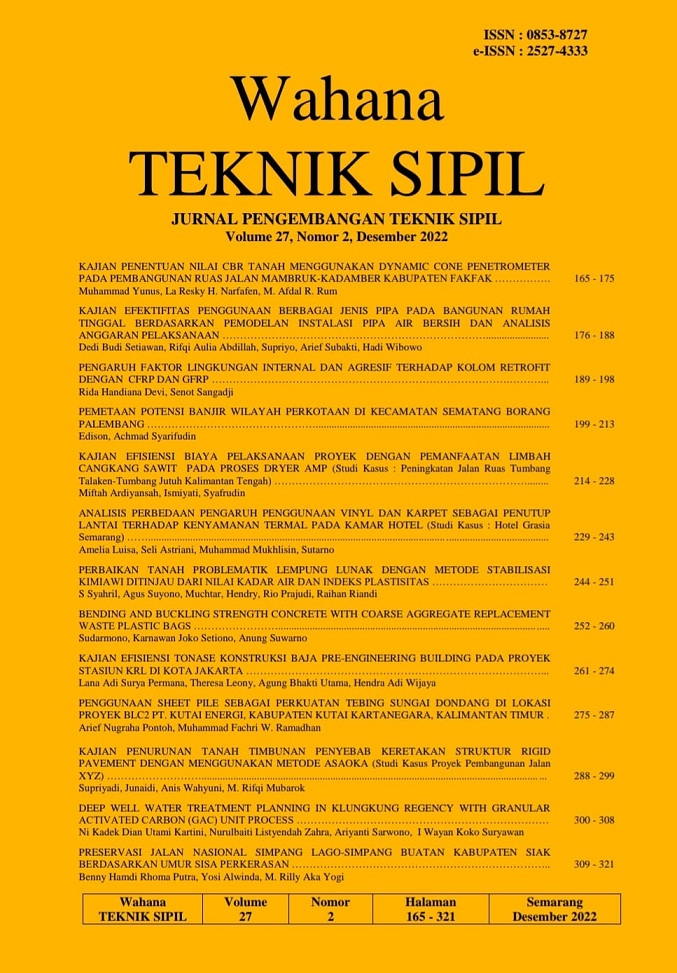ANALISIS PERBEDAAN PENGARUH PENGGUNAAN VINYL DAN KARPET SEBAGAI PENUTUP LANTAI TERHADAP KENYAMANAN TERMAL PADA KAMAR HOTEL (Studi Kasus : Hotel Grasia Semarang)
DOI:
https://doi.org/10.32497/wahanats.v27i2.4144Keywords:
Vinyl, Karpet, Kenyamanan Termal, Kamar HotelAbstract
Replacing the floor covering from carpet with vinyl is an effort to increase the
comfort of room users and the effectiveness of carrying out maintenance. However,
the use of vinyl and carpet as floor coverings for hotel rooms has an influence on
thermal comfort. So it is necessary to analyze the effect of using vinyl and carpet as
floor coverings on thermal comfort in hotel rooms. The research method used is
descriptive quantitative. This research is in the form of measuring temperature,
humidity, and lighting in rooms 204, 206, 222, and 224 Hotel Grasia Semarang.
Rooms with vinyl floor coverings tend to be comfortable in the morning (-0,5 ≤ PMV
value ≤ +0,5), during the day the thermal comfort can worsen (if PMV value ≤ -0,5
or PMV value ≥ +0,5), and in the afternoon tend to be comfortable. While rooms
with carpet floor coverings in the morning tend to be comfortable, during the day
References
Ahmad, A.S., Shukor, S.A., Kohlhof, K., Jamal, Z.A.Z., & Mohamad, A., 2015, Analyzing and Evaluating a PMV-Based Thermal Comfort Model in Controlling Air Conditioning System. Jurnal Teknologi (Sciences & Engineering), Volume 77, Nomor 28, (99-106).
Aienna, Adyatma, A., & Arisanty, D., 2016, Kenyamanan Termal Ruang Kelas di Sekolah Tingkat SMA Banjarmasin Timur. Jurnal Pendidikan Geografi Volume 3, Nomor 3, (1-12).
Baharuddin, M.T.I., Beddu, S., & Yahya, M., 2012, Kenyamanan Termal Gedung Kuliah Bersama Kampus Baru Fakultas Teknik Universitas Hasanuddin. Jurnal Teknologi dan Sains Terapan LP2M Universitas Hasanuddin.
Fanger, P.O., 1970, Thermal Comfort. Analysis and applications in environmental engineering. Thermal comfort. Analysis and applications in environmental engineering. Copenhagen: Danish Technical Press.
Hadi, Y., Azaria, T., Purnomo, Putrianto, N.K., Oktiarso, T., Ekawati, Y., & Noya, S., 2020, Analisis Kenyamanan Termal Ruang Kuliah. Jurnal Metris 21, (13-26). ISSN 1411-3287.
Ismail, A.R., Karagaratnan, S.K.S., Zulkifli, R., Deros, B.M., & Rahman, M.N.A., 2012, A Reviewo on Thermal Comfort Assessment in Malaysian Industries. Jurnal Teknologi (Sciences & Engineering), Volume 59, Nomor 2, (7-11).
Istiningrum, D.T., Arumintia, R.L., Mukhlisin, M., & Rochadi, M.T., 2017, Kajian Kenyamanan Termal Ruang Kuliah pada Gedung Sekolah C Lantai 2 Politeknik Negeri Semarang. Wahana Teknik Sipil: Jurnal Pengembangan Teknik Sipil, Volume 22, Nomor 1, (1-16).
Latif, S., Rahim, R., & Hamzah, B., 2016, Analisis Kenyamanan Termal Siswa di Dalam Ruang Kelas (Studi Kasus SD Inpres Tamalanrea IV Makassar).Simposium Nasional RAPI XV -2016 FT UMS ISSN 1412-9612.
Mastovani, R., Nugroho, S., & Indarto, E., 2014, Hotel Bisnis Bintang 4 Di Kota Semarang. PhD Thesis. Universitas Diponegoro FT. Jurusan Arsitektur.
Noman, F.G., Kamsah, N., & Kamar, H.M., 2016, Improvement of Thermal Comfort Inside a Mosque Building. Jurnal Teknologi (Sciences & Engineering), Volume 7 Nomor 8, (9-18).
Saputra, R., Hartanti, N.B., & Walaretina, R., 2021, Pemilihan Material Penutup Lantai untuk Kenyamanan Ruang Shalat Masjid Agung di Banjarbaru. Prosiding Seminar Intelektual Muda. Volume 3, Nomor 1, (22-27).
Syah, F.F., & Nugroho, M.S.P., 2013, Kenyamanan Termal Gedung Setda Kudus. Sinektika: Jurnal Arsitektur, Volume 13, Nomor 2, (105-113).
Downloads
Published
Issue
Section
License
Authors who publish with this journal agree to the following terms:Authors retain copyright and grant the journal right of first publication with the work simultaneously licensed under a Creative Commons Attribution License that allows others to share the work with an acknowledgement of the work's authorship and initial publication in this journal.
Authors are able to enter into separate, additional contractual arrangements for the non-exclusive distribution of the journal's published version of the work (e.g., post it to an institutional repository or publish it in a book), with an acknowledgement of its initial publication in this journal.
Authors are permitted and encouraged to post their work online (e.g., in institutional repositories or on their website) prior to and during the submission process, as it can lead to productive exchanges, as well as earlier and greater citation of published work (See The Effect of Open Access).






